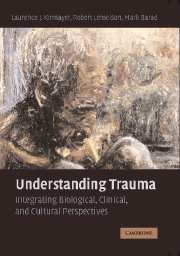Book contents
- Frontmatter
- Contents
- List of Figures
- List of Tables
- List of Contributors
- Foreword by Robert Jay Lifton
- Preface
- List of Abbreviations
- Introduction: Inscribing Trauma in Culture, Brain, and Body
- SECTION I NEUROBIOLOGICAL PERSPECTIVES ON TRAUMA
- 1 Neurobiological and Neuroethological Perspectives on Fear and Anxiety
- 2 Some Biobehavioral Insights into Persistent Effects of Emotional Trauma
- 3 Learning Not to Fear: A Neural Systems Approach
- 4 Mechanisms of Fear Extinction: Toward Improved Treatment for Anxiety
- 5 Developmental Origins of Neurobiological Vulnerability for PTSD
- 6 Does Stress Damage the Brain?
- 7 Somatic Manifestations of Traumatic Stress
- SECTION II CLINICAL PERSPECTIVES ON TRAUMA
- SECTION III CULTURAL PERSPECTIVES ON TRAUMA
- Epilogue: Trauma and the Vicissitudes of Interdisciplinary Integration
- Glossary
- Index
- References
7 - Somatic Manifestations of Traumatic Stress
Published online by Cambridge University Press: 27 July 2009
- Frontmatter
- Contents
- List of Figures
- List of Tables
- List of Contributors
- Foreword by Robert Jay Lifton
- Preface
- List of Abbreviations
- Introduction: Inscribing Trauma in Culture, Brain, and Body
- SECTION I NEUROBIOLOGICAL PERSPECTIVES ON TRAUMA
- 1 Neurobiological and Neuroethological Perspectives on Fear and Anxiety
- 2 Some Biobehavioral Insights into Persistent Effects of Emotional Trauma
- 3 Learning Not to Fear: A Neural Systems Approach
- 4 Mechanisms of Fear Extinction: Toward Improved Treatment for Anxiety
- 5 Developmental Origins of Neurobiological Vulnerability for PTSD
- 6 Does Stress Damage the Brain?
- 7 Somatic Manifestations of Traumatic Stress
- SECTION II CLINICAL PERSPECTIVES ON TRAUMA
- SECTION III CULTURAL PERSPECTIVES ON TRAUMA
- Epilogue: Trauma and the Vicissitudes of Interdisciplinary Integration
- Glossary
- Index
- References
Summary
INTRODUCTION
Traumatic stress can be associated with adverse mental and physical health outcomes (Friedman & Schnurr, 1995; Lamprecht & Sack, 2002). Whereas the impact of traumatic stress on mental health is typically referred to as posttraumatic stress disorder (PTSD), there is a wide range of somatic symptoms and syndromes related to different organ systems that have been reported in association with trauma. These include cardiovascular, gastrointestinal, dermatological, ophthalmological, and gynecological symptoms (Friedman & Schnurr, 1995). Pain problems figure prominently amongst patients' complaints including headaches, musculoskeletal pain, chest pain, abdominal pain, and pelvic pain. Somatic symptoms have been reported after different types of trauma, including sexual abuse, and natural disasters, and have been reported after every military conflict since 1864. This chapter will discuss the relationship of traumatic stress with somatic symptoms focusing on so-called medically unexplained or “functional” syndromes, in particular, irritable bowel syndrome (IBS) and fibromyalgia (FM). Both syndromes are commonly reported by PTSD patients, and affected patients frequently show comorbidity with disorders of mood and affect (Campbell, Clauw, & Keefe, 2003; Mayer, Craske, & Naliboff, 2001; Williams, Brown, Clauw, & Gendreau, 2003).
Somatic responses associated with normal emotions and somatic manifestations of traumatic stress can be conceptualized as normal and pathological outputs of the emotional motor system (EMS; Figure 7.1; Holstege, Bandler, & Saper, 1996). The EMS refers to brain circuits generating parallel outputs to the body and brain that mediate the distinct pattern of the organism's response associated with emotional activation.
- Type
- Chapter
- Information
- Understanding TraumaIntegrating Biological, Clinical, and Cultural Perspectives, pp. 142 - 170Publisher: Cambridge University PressPrint publication year: 2007
References
- 8
- Cited by

